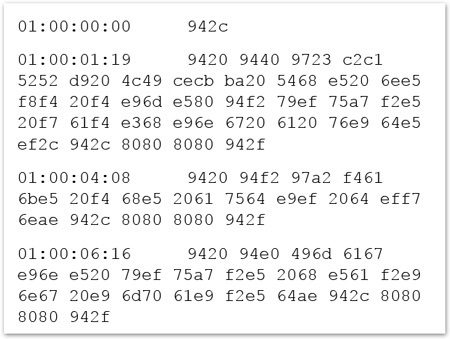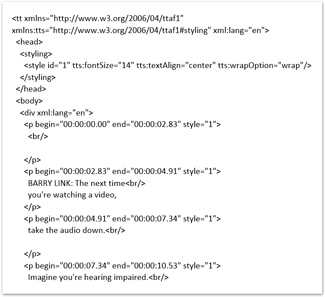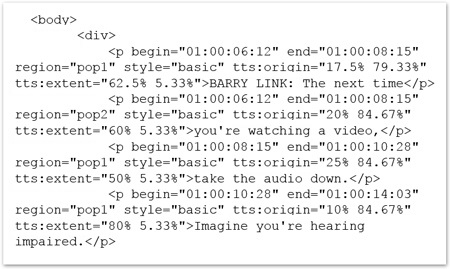Caption Formats: Acronyms Explained
Understanding all of the caption formats and selecting the right one is essential in creating accessible, platform-ready video content. If you’ve encountered acronyms like SRT, WebVTT, or SMPTE-TT and aren’t sure what they mean, this guide provides a clear breakdown of the most common caption formats, their key features, and where they are best used.
Caption Formats: Table of Contents
What does SRT stand for?

What does SRT stand for?
SRT stands for SubRip Subtitle, a widely used caption file format known for its simplicity and compatibility. It’s commonly used for videos on platforms like YouTube and Facebook, and contains timing and plain-text dialogue without complex formatting.
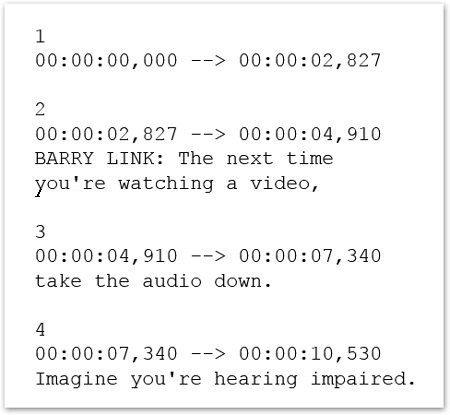
SRT stands for SubRip Subtitle, widely used among the caption formats and known for its simplicity, adaptability, and compatibility. Originally developed from DVD-ripping software, SRT files are plain text and easy to read, containing a numbered sequence, timecodes, and caption text.
They’re supported by platforms like YouTube and are ideal for both closed captions and subtitles. While basic in structure, they support many languages and can sometimes be used in editing software for burned-in captions.
A caption frame in SRT consists of:
- A number indicating which subtitle it is in the sequence.
- The time that the subtitle should appear on the screen, and then disappear.
- The caption text.
- A blank line that indicates the start of a new subtitle.
→ View Compatible Platforms
- YouTube
- Brightcove
- Windows Media Player
- Wistia
- Canvas
- Slideshare
- Adobe Presenter
- Camtasia
- Kaltura
- MediaSpace
- Flowplayer
- MediaPlatform
- Mediasite
- Vidyard
- Vimeo
- & more…
What does WebVTT stand for?
WebVTT stands for Web Video Text Tracks. It’s a modern, user-friendly caption format designed for the web and based on the SRT format, but with added features like text styling, positioning, and support for different rendering modes.
WebVTT is widely supported across HTML5 video players and preferred by platforms like Vimeo. Though it closely resembles SRT in structure, its enhanced styling capabilities make it a popular choice for delivering captions with more control over visual presentation.
WebVTT caption files are compatible with videos on cloud-based, HTML5 media players and video management systems.
WebVTT caption files are compatible with videos on cloud-based, HTML5 media players and video management systems.
→ View Compatible Platforms
- Vimeo
- Brightcove
- JW Player
- MediaPlatform
- Video.js
- YouTube
- & more…
What does SCC stand for?
SCC (.scc) stands for “Scenarist Closed Captions.” It’s commonly used with broadcast and web video, and DVDs and VHS videos.
SCC file data is based on closed captioning data for CEA-608. i.e., Line 21 or EIA-608 broadcast data; this used to be the standard transmission format for closed captions in North America.
→ View Compatible Platforms
- Adobe Encore
- Adobe Premiere Pro
- Apple Compressor
- DVD Studio Pro
- Final Cut Pro
- YouTube
- & more…
What does STL stand for?
STL stands for “Spruce Subtitle File.” It was developed by Spruce Technologies primarily for use in DVD Studio Pro software. The STL format allows you to configure most subtitle settings and change the settings on a subtitle-by-subtitle basis.
STL subtitle files consist of:
- Commands: These are preceded by the dollar sign ($). It is these commands that allow you to configure the various aspects of the subtitles, such as their font and position.
- Comments: These are preceded by a double slash (//). These allow you to add text comments throughout the subtitle file without affecting its import.
- Entries: These include the start and end timecode values and the text or graphics file for that subtitle clip.
→ View Compatible Platforms
- DVD Studio Pro
What does DFXP stand for?
DFXP (.dfxp) stands for “Distribution Format Exchange Profile.” It’s a timed-text format that was developed by W3C and is most commonly used for Flash video captions. DFXP is used by many online video providers, but typically in a limited role without full CEA-608 features (making that video non-compliant with the CVAA rules for TV content online).
DFXP caption files are compatible with videos on media players, lecture capture software, and video management systems.
→ View Compatible Platforms
What does TTML stand for?
TTML stands for “Timed Text Markup Language.” TTML a class of XML file that can come in various formats, including DFXP. XML stands for Extensible Markup Language file and can come in many formats, the most common being TTML, DFXP, and SMPTE-TT. Most of these variations can be used for multiple languages, which makes them quite useful for localization and subtitling, but support of other stylistic features varies between XMLs.
TTML is often used interchangeably with the term DFXP, although there can be TTML files that are formatted slightly differently from DFXP. TTML files have the file extension (.ttml).
TTML caption files are compatible with videos on media players, lecture capture software, and video recording software.
→ View Compatible Platforms
- MS Office Mix PowerPoint presentations (with PowerPoint 2013 or later)
- Flowplayer
- Ooyala
- YouTube
- & more…
What does SMPTE-TT stand for?
SMPTE-TT stands for the “Society of Motion Picture and Television Engineering – Timed Text.” It is a type of XML file developed by SMPTE.
Television content providers like to use SMPTE-TT because it is compliant with FCC closed caption regulations for broadcasters, unlike other formats like DFXP. Another important difference of SMPTE-TT captions is that they reference video frames instead of video time. SMPTE-TT files end is extension .xml.
Four features that set SMPTE-TT apart from DFXP/TTML:
- The #image attribute can display .png images.
- The #data feature allows the player to pass CEA-708 data (the standard for captioning digital TV) through to the video player, as well as CEA-608 data (the line-21 standard for broadcast TV captioning).
- SMPTE-TT attributes are traditionally associated with subtitles, including foreign-alphabet characters and some mathematical symbols.
- The #information feature tells the player whether to display the caption data with the original look and feel (preserve mode) or to take advantage of the more advanced display capabilities (enhance mode).
What does QT stand for?
QT stands for “QuickTime.” Developed by Apple, QT is used exclusively for QuickTime Pro video or audio files.
→ View Compatible Platforms
What does CAP stand for?
This is a common subtitle/caption file format for broadcast media. It was developed by Cheetah International to accommodate characters in many languages for international use. Cheetah files have the file extension .asc or .cap. This format is used in professional video editing systems.
What does CPT.XML stand for?
CPT.XML stands for “Captionate XML.” It’s an XML format originating in the caption-embedding software Captionate and used for encoding captions into Flash video.
→ View Compatible Platforms
- Captionate
- Adobe Flash
What does PPT.XML stand for?
PPT.XML stands for “PowerPoint XML,” a customized TTML file that works with STAMP in PowerPoint.
→ View Compatible Platforms
- PowerPoint 2010 or earlier
- Lectora
- & more…
What does EBU.STL stand for?
EBU.STL stands for “European Broadcasting Union subtitles.” This is a common subtitle/caption file format for PAL broadcast media in Europe. EBU.STL captions are typically used in professional video editing systems, like Avid.
What does RT stand for?
RealText (.rt) captions are timed-text file for RealMedia. Similar to SMIL markup, RealText is a very simple text file that consumes minimal bandwidth and streams quickly to RealOne Player.
→ View Compatible Platforms
- RealPlayer
- RealOne Player
What does SAMI or SMI stand for?
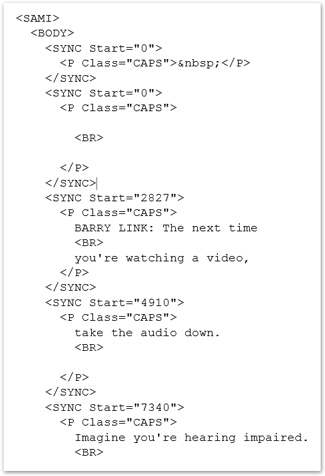
→ View Compatible Platforms
- Windows Media Player
- YouTube
- & more…
What does SBV or SUB stand for?
SBV or SUB both stand for “SubViewer.” This is a very simple YouTube caption file format that doesn’t recognize style markup. It’s a text format that is very similar to SRT.
→ View Compatible Platforms
Other Caption File Formats
These formats are examples of customized or less frequently used caption file types. For many of these, more common caption formats may be substituted.
→ Additional Caption Formats
- ADBE – Adobe
- Apple XML – Apple XML Interchange Format
- AAF – Avid
- Avid DS – Avid
- CCA – MacCaption
- ONL – CPC 715
- Crackle TT – Crackle Timed Text (variant of SMPTE-TT)
- DECE CFF – Variant of SMPTE-TT with auxiliary PNG files
- Evertz ProCAP
- ITT – iTunes Timed Text
- Matrox4VANC – Matrox for MX02
- MCC – MacCaption
- MCC V2 – MacCaption
- Multiplexed SCC – Multiple CC
- Rhozet – XML file
- SonyPictures TT – Sony Pictures Timed Text XML
- TIDLP Cinema – Texas Instruments DLP Cinema XML
- WMP.TXT – Windows Media timed text file
- LRC (.lrc) – No styling, but enhanced format supported.
- Videotron Lambda (.cap) – Primarily used for Japanese subtitles.
This blog post was originally published on March 5, 2015, by Emily Griffin. It has since been updated for accuracy, clarity, and freshness.




